What is a VRIO Framework?
VRIO stands for value, rarity, inimitability, and organization. The VRIO framework is a useful tool designed to help organizations identify and leverage the unique resources and capabilities that make long-term, sustainable competitive advantages.
It’s important to remember that the VRIO framework evaluates strengths, resources, and assets as the source of competitive advantages. As a quick refresher, sustainable competitive advantages are a set of assets, characteristics, or capabilities that allow an organization to meet its customer needs better than its competition, thereby achieving a long-term competitive advantage.
Competitive advantages are difficult to duplicate or replicate. Check out our post on competitive advantages here.
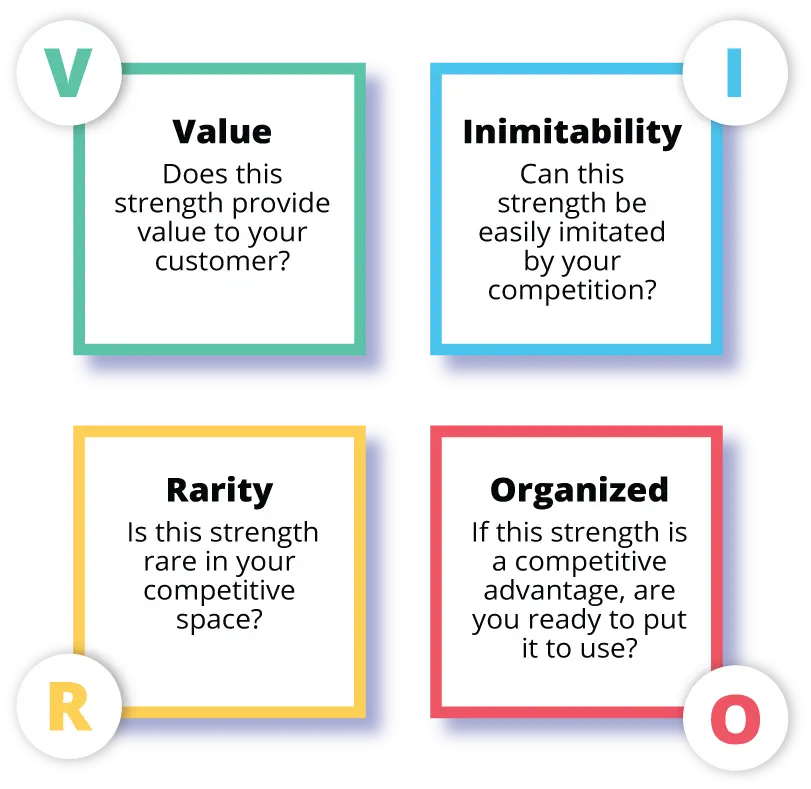
Pro Tip:
Competitive advantages aren’t just a list of strengths. The VRIO framework evaluates your strengths to help you identify which are your competitive advantages and which are just strengths.
⚠️ Caution! Do not proceed with the VRIO framework unless you’ve completed your SWOT Analysis
Before using the VRIO framework, you must complete a SWOT analysis to gather your organization’s current-state strengths to evaluate for competitive advantages. This is because VRIO, at its core, looks at your current state strengths to consider competitive advantages.
Download the Free VRIO Guide
Get The GuideOther articles and resources will recommend that you evaluate all of your strengths, resources, and internal forces for competitive advantages. We disagree. Arbitrarily running all your organization’s attributes, assets, and strengths through this framework will be exhausting and less fruitful than a focused effort. Check out the SWOT guide here.
Breaking Down the VRIO Framework
As we break down the core components of the VRIO acronym, we will examine how to evaluate your core strengths against each piece. This analysis is a crucial part of the strategic management and planning process as it identifies competitive advantages to use as the foundation of a growth strategy, strategic objectives, and aligning your resources to achieve your vision.
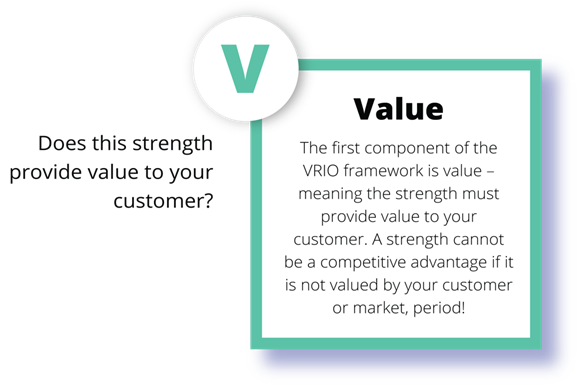
Value
The first component of the VRIO framework is value – meaning the strength or attribute must be one of your valuable resources providing value to your customer. A strength cannot be a competitive advantage if it is not valued by your customer or market, period!
Questions to consider:
- Does the strength add value to customers?
- Can you capitalize on it to grow your organization, or beat your competitors?
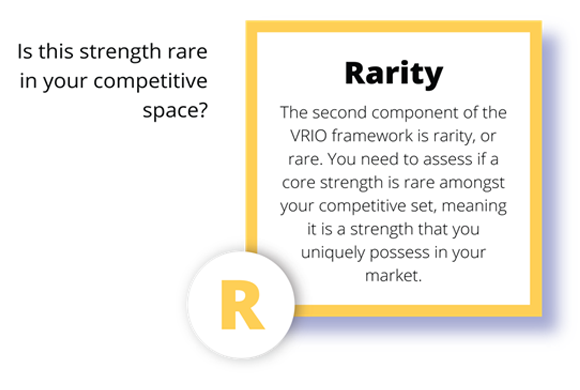
Rarity
The second component of the VRIO framework is rarity, or rare resources. You need to assess if a core strength is rare amongst your competitive set, meaning it is a strength that you uniquely possess in your market.
By definition, sustainable competitive advantages are key advantages your organization possesses. If your competitors also possess it, it is no longer an advantage.
Questions to consider:
- Is this strength unique to your organization?
- Do your competitors also possess this strength?
If it’s not rare in your competitive market, it’s just a table stake. Maintain the strength to stay competitive in your market, but it’s probably not key to your growth strategy.
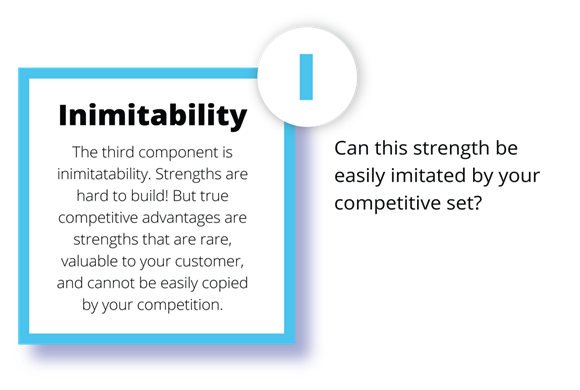
Inimitability
The next step is to evaluate if a strength can be easily imitated. We all know strengths are hard to build! But true competitive advantages are strengths that are rare, valuable to your customer, and cannot be easily copied or imitated by your competition.
So, for strength to be a competitive advantage, it has to be inimitable – yes it’s a mouthful, and it’s a little silly to say. Just remember that it can’t be copied. If it can, it might be a shorter-term market advantage.
Questions to consider:
- Can this strength be easily copied by your competition? Would it take a significant effort to replicate this strength?
- Would you consider this strength one of your competitive moats – meaning it would be hard for your competition to penetrate?
Completing the inimitable analysis:
- If the strength is hard to imitate, move on to the final section of this framework.
- If it’s a strength, it’s unique, it’s rare, but your competition can copy it; feel free to use it short-term in your growth strategy.
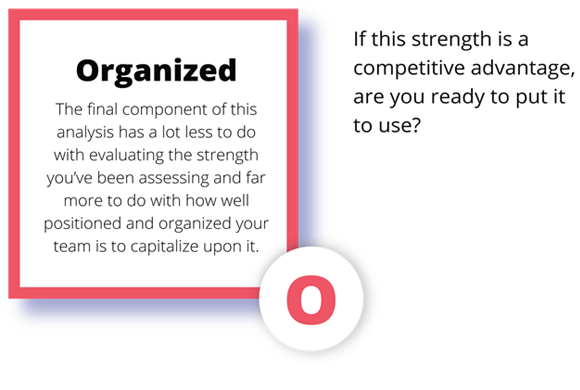
Organized
The final component of this analysis has a lot less to do with evaluating the strength you’ve been assessing and far more to do with how well positioned and organized your team is to capitalize upon it.
Essentially, a strength cannot be realized as a competitive advantage until your team decides to leverage it! There are many ways we recommend competitive advantages – as fodder for your strategic plan’s annual objectives, as the backbone of your organization’s core growth strategies, and to help set the direction of your organization’s future.
Questions to consider:
- How are you going to leverage this competitive advantage?
- Are you going to use this to create your growth strategy?
- Will you use this to start or drive your vision of the future?
- How will you use this advantage in your organization’s strategic plan and annual objectives?
Completing the inimitable analysis:
- If you know how to use this competitive advantage, you’re all set!
- If you’re unsure how to leverage it, check out our growth strategy guide, visioning guide, and guide for setting strategic objectives for inspiration.
3 Steps to Implement the VRIO Framework
Implementing a VRIO (Value, Rarity, Imitability, Organization) framework requires evaluating your organization’s resources, capabilities, and competitive strengths to determine if they are sustainable competitive advantages. Integrating the VRIO framework into your strategic planning process can streamline decision-making and goal tracking, enhancing internal resource evaluation.
Here’s a step-by-step guide on how to implement a VRIO framework:
Step 1: Identify Key Resources and Capabilities
- Resources:These are the assets that the organization owns, such as financial capital, brand reputation, technology, or human talent. Identifying rare and valuable resources is crucial as they provide a competitive advantage that can only be acquired by a limited number of companies.
- Capabilities:These refer to the organization’s ability to effectively utilize its resources, such as operational efficiency, innovation processes, or customer service excellence.
- Strengths:tThese are your internal strengths that have the potential to catapult your organization toward its desired future state.
Step 2: Evaluate Resources, Capabilities, and Strengths Using VRIO Criteria
Create a list of your valuable and rare resources, strengths, and capabilities. Then, evaluate if each meets ALL of the criteria below.
Is it Valuable (V) to the Market?
Question 1:Does our organization’s resource, capability, or strength enable it to exploit opportunities or neutralize threats in the market?
Question 2: Do these attributes have the potential to help us achieve our vision of the future by helping our organization increase revenue, reduce costs, improve efficiencies, or create new fields of play?
If you answer yes to both questions, move forward.
Is it Rare (R) in Your Competitive Space?
Question 4: Is this attribute, resource, capability, or strength unique to our organization and market? No other competitors can also have these attributes. If it is “rare” in your marketplace or competitive set, move forward.
Is it Hard to Imitate?
Question 5: Is it hard to imitate? Your competitors cannot easily replicate this resource, capability, or attribute.
Resources that are costly or difficult to imitate (due to unique historical conditions, causal ambiguity, or social complexity) provide a more sustained competitive advantage. These must be really unique assets, resources, or capabilities.If it is not easily copied, move forward.
Is Your Organization Ready to Capitalize
Question 6: Is your organization structured, and is it using its resources effectively to capitalize on them? Your organization must have the right processes, management systems, and structures in place to fully leverage valuable, rare, and hard-to-imitate resources.After all, you should use these competencies to increase your organization’s position and market share in your space.
If you’re structured to use this competitive advantage, move forward.
Bonus: It Matters to Your Customer/Market
One common mistake made using the VRIO framework and analysis is identifying advantages, strengths, or resources that don’t provide real value to your customers or market. It is probably not a competitive advantage if it doesn’t positively impact your customer.
Step 3: Prioritize Strategic Investments and Build Your Growth Strategy
After you’ve identified your unique competitive advantages, you need to put them to work. This requires identifying your strategic investments and how you will use these advantages in your organization’s growth strategy. Incorporating the VRIO framework can help ensure these efforts contribute to a sustainable competitive advantage.
Common Mistakes in VRIO Analysis
- Identifying Advantages that Aren’t Valuable to Your Customer/Market: If a resource is not valuable, the organization is likely at a competitive disadvantage.
- Mistaking Advantages for a Competitive Parity: If a resource is valuable but not rare, the organization will achieve parity with competitors. Be especially careful here with identifying “off the shelf” AI capabilities or tools as sources of competitive advantage. Artificial intelligence is being widely adopted, so make sure your competitors would have a hard time using AI in the same competitive position.
- Identifying Only Temporary Advantages: If a resource is valuable and rare but can be imitated, it provides a temporary competitive advantage.
Implementing a VRIO framework helps make informed strategic decisions by enabling an understanding of which resources and capabilities can provide a sustainable competitive edge and where the organization should focus its growth efforts.
Evaluating if you got the VRIO framework right
- The output gives you advantages that are the best of your core strengths.
Your identified competitive advantages are also the best of the organization’s core strengths. We recommend completing a SWOT analysis before considering the organization’s competitive advantages.
- Your advantages represent what your customers value most about your organization.
If you were to acquire a new customer right now, would that new customer value this advantage? The answer needs to be yes.
- Your advantages represent what your customers value most about your organization.
True competitive advantages are difficult for competitors to replicate. These advantages give you a long-term edge that makes it harder for competitors to compete with you.
What To Do After Competing Your VRIO analysis
Build a Growth Strategy
The most important thing you can do with your newly minted competitive advantages is leveraging them in your growth strategy! You can check out the full guide on building a growth strategy here.
Revise or Create a Vision Statement for the Future
Build Your Plan’s Annual Objectives and Strategic Roadmap
Core advantages need to be used and leveraged as you build your organization’s core objectives and key results. You can check out the OKR guide here.
Pros and Cons of Using the VRIO Framework
- Identifies Advantages: Very simply, this exercise helps identify advantages!
- Informs Growth Strategy: The output from this exercise helps build your advantages, which are used at the very core of your growth strategy – and every organization needs an approach to growth!
- Easy to Follow: Many teams like to use this framework because it’s a linear approach to evaluating strengths. Sometimes following a linear approach is nice!
- Acronym is Confusing: The acronym itself is a little confusing and clunky to remember.
- It can get unfocused: Other resources tell you to run all of your strengths, resources, and capabilities through this framework. If you follow that advice, it can get unfocused.
- Only focused on internal analysis: Like many competitive advantage exercises, it only focuses on internal strengths. You also need external opportunities to build a great growth strategy.
SWOT vs. VRIO: What are the differences?
Strategic planning processes use several tools and frameworks, including SWOT and VRIO. While both SWOT and VRIO can be used in the early stages of strategic planning, they are different tools with different purposes.
SWOT focuses more broadly on assessing strengths, weaknesses, opportunities, and threats that may arise from internal and external factors; it can help prioritize your strategic initiatives by looking at what you’re doing well and not well internally and what external market forces are headwinds and tailwinds.
These VRIO framework examples helps you evaluate your internal strengths to assess their potential to strengthen your firm’s competitiveness; it is useful when conducting an internal analysis to pinpoint areas of lasting competitive advantage.

Competitive Advantages vs. VRIO Framework: What are the differences?
The VRIO is used to identify competitive advantages. They are interrelated, but not the same thing.
VRIO assesses your strengths to see if they’re valuable to your customer, rare in your marketplace, inimitable by your competition, and organized to be used in your plan.
Competitive advantages are core strengths that are unique to your organization and are the backbone of your growth strategy.
Are there other ways to identify competitive advantages than using VRIO?
Yes, there are other ways and exercises you can use to identify your competitive advantages! You can check out our full guide, canvas, and video on competitive advantages.
FAQs
What does each letter in VRIO mean?
A VRIO analysis looks at whether an organization’s strengths are valuable, rare (within the market), inimitable (not easy to replicate), and organized (the organization is able to take full advantage of its resources and capabilities).
When should an organization use the VRIO framework?
The VRIO analysis works well when paired with a SWOT analysis. It allows organizations to take a closer look at their strengths and how those strengths are uniquely positioned to set your organization above the competition in the market.
Why is a VRIO analysis useful?
A VRIO analysis helps you understand which of your strengths are the BEST of your core strengths and helps you determine which of your strengths your customers may value the most. The analysis also allows you to see what resources you must use to sustain these strengths as competitive advantages.












